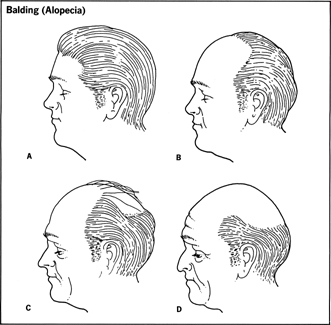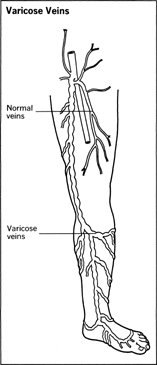Keeping Fit - Problems of aging
When the human body reaches middle age, a number of problems and conditions that are the result of advancing years begin to make themselves felt. These include wrinkling of the skin, baldness, varicose veins, menopause and the male climacteric, and the body's decreased ability to deal with nicotine, caffeine, alcohol, and excess calories.
Skin
The skin usually starts to show its age in the mid to late 30s. At that time it starts to lose its elasticity and flexibility, and becomes somewhat thinner. Little lines—not yet wrinkles—start to show up, usually crow's feet around the eyes.
Wrinkling takes place at different times with different people, and sometimes in different areas of the skin. Heredity may play a part. For instance, one family may have the trait of wrinkling around the mouth rather than the eyes. In another family, wrinkling or crow's feet may start early and then stop.
Treatment for Wrinkles
While wrinkles do not hurt, many people want to do something about them. Experienced physicians and dermatologists have a number of techniques for removing or minimizing wrinkles. One accepted method is dermabrasion, or planing of the skin with a sanding instrument. Laser resurfacing is another surgical procedure to smooth out wrinkles by removing the top layers of the skin. Chemical peels have a similar effect.
Dermal fillers such as collagen may be injected to fill out deeper wrinkles and creases. Another injectable treatment is the botulinum toxin, or botox, which temporarily paralyzes the muscles that create creases in the skin. The facial lines then gradually lessen with disuse.
The use of retinoic acid, or tretinoin (available as the topical prescription medications Retin-A™ and Renova™), for the treatment of fine wrinkles has become popular. Retinoic acid was originally used for the treatment of acne and has not yet been studied for long-term use for wrinkles. Side effects may include heightened sensitivity to sunlight and skin irritation or rash. Alpha and beta hydroxy acids, available in many over-the-counter cosmetics, peel off the top layers of skin to speed rejuvenation.
Skin Texture Change
Besides wrinkling, the skin has a tendency in some people to become thinner, leathery, and darkened as they move towards the 40s and 50s. This effect can be minimized if the skin is toned up with cold cream and other emollients that provide the moisture and oil the skin needs. Also, overexposure to the sun—one of the prime agers of the skin—should be avoided.
In fact, most physicians feel that the sun is a lethal agent. Its aging effects on the skin are well documented, as is the role of excessive sun exposure in causing skin cancers.
Cosmetic Surgery
Cosmetic surgery for both men and women is becoming increasingly popular and sophisticated. Cosmetic surgery procedures include rhinoplasty (nose); facialplasty or rhytidoplasty (face lift); blepharoplasty (upper eyelids and bags under the eyes); breast augmentation and reduction; as well as the dermabrasion and other methods mentioned earlier. See “Plastic and Cosmetic Surgery” in Ch. 20, Surgery .
Baldness
The occurrence of baldness (medically known as alopecia ) and attempts at concealing or reversing it can be traced back thousands of years. For example, in ancient Egypt bald men used a mixture of fats to cover their heads. Today there are several options for treating baldness, though baldness is typically caused by factors that cannot be altered, such as aging and heredity.
Other causes of male baldness include infections, systemic diseases, drugs that have a toxic effect, mechanical stress, friction, and radiation. Diet does not usually affect baldness, but chronic starvation or vitamin deficiencies can contribute to dryness, lack of luster, and hair loss. Also, excessive intake of vitamin A can cause hair loss.
In women, loss of hair is quite common toward the end of pregnancy, after delivery, and during menopause. A hysterectomy, crash dieting, severe emotional stress, high fever, a major illness such as thyroid disease or diabetes, certain allergies, and the use of systemic drugs such as steroids and amphetamines—all can produce hair loss.
The most common form of baldness is androgenetic alopecia . It is commonly known as either male pattern baldness or female pattern baldness (depending, of course, on whether the affected person is male or female). With this type of baldness, hair follicles shut down, becoming unproductive. Experts believe that hormones play some role in this process. Alopecia areata is an autoimmune disease in which hair may suddenly fall out in patches. Other body hair, such as eyebrows and eyelashes, may also be lost. In many cases, the hair will grow back, although it may be thinner than before.

Male Pattern Baldness
Male pattern baldness may begin as early as the late teens, the 20s, or 30s. With this type of baldness the hairline at the forehead recedes and hair begins to fall out at the crown of the head. Eventually only a fringe of hair remains at the sides and along the back of the head.
Female Pattern Baldness
Female pattern baldness may begin in the 30s or 40s and become more noticeable after a woman experiences menopause. This type of baldness is characterized by an overall thinning out of the hair.
Treatments
Although many people are perfectly comfortable with their baldness, others find it a distressing condition they wish to change. Today there are several methods of treatment for these people.
Two surgical methods are hair transplantation and scalp reduction . For hair transplantation a doctor removes, usually from the back of the patient's head, small sections of follicle-bearing tissue and hair called grafts . These grafts are placed in recipient incisions in the bald areas of the head. This can be an expensive, time consuming, and painful process.
Scalp reduction is the process in which sections of bald scalp are surgically removed and the remaining hair-covered areas are pulled more closely together. Sometimes elastic expanding devices are first placed under hair-covered areas of the scalp, stretching the hair-covered skin so that it will cover a larger area. This can be a costly and painful process.
Drug therapy is used for the non-surgical treatment of baldness. The most commonly used drug is minoxidil, a topical drug (a drug placed directly on the scalp) that has been approved by the FDA for promoting hair growth. Minoxidil is now available over-the-counter in such products as Rogaine. It must be used twice daily and works best for younger patients whose hair loss is fairly recent. Minoxidil, however, does not work effectively for many people. If hair regrowth does occur, the patient must continue to use minoxidil or the new hair will fall out. It can take from four months to a year to see results. The FDA has also approved Propecia, a prescription medicine in pill form, for hair growth. Propecia, however, can only be used to treat male pattern baldness. As with minoxidil, if hair re-growth occurs, a patient must continue to take the pill or the new hair will fall out.
Hair weaves and hairpieces are also options for those wishing to change their appearance. A hair weave is a wig that is attached by sewing it to existing hair. Hairpieces, or toupees, are wigs that are attached to the scalp with such methods as glues or tapes.
Excess Hair
For some middle-aged women, the problem is too much hair in the wrong place, instead of too little. Excess hair can grow on the face, chest, arms, and legs. In some instances, unwanted hair may be a sign of an endocrine disorder that can be detected by a physician. In other cases, it can be caused by chronic irritation, such as prolonged use of a cast, bandage, or hot-water bottle; it can also be due to excess exposure to the sun, iodine or mercury irritation, or localized rubbing.
Excess hair can be bleached, shaved, tweezed, waxed, or removed by chemical depilatories and electrolysis. Only electrolysis is permanent. See “Hair Removal” in Ch. 21, Skin and Hair .
Varicose Veins
Another complaint of middle-aged men and women is varicose veins . About half the women over 50 years of age have these enlarged veins with damaged valves in their thighs and calves.
Varicose veins can occur in various parts of the body. They are, however, most common in the legs.
Varicose veins are usually caused by years of downward pressure on the veins, causing the valves to break down. This often happens to people who must stand for many hours at a time. The large, bluish irregularities are plainly visible beneath the skin of the thighs and calves, and they cause a heavy dragging sensation in the legs and a general feeling of tiredness and lack of energy.

Treatment
In most instances, the best treatment involves surgery to tie off the main veins and remove all superficial veins that lend themselves to this procedure (called stripping ). In other cases, varicose veins can be relieved by wearing elastic stockings or compression bandages.
Varicose veins that remain untreated can cause varicose ulcers , which usually form on the inner side of the leg above the ankle. Treatment calls for prolonged bed rest, warm applications, and surgical ligation and stripping of the varicose veins responsible for the ulcers. Thus, it is wise to consult a physician if varicose veins appear.

Comment about this article, ask questions, or add new information about this topic: